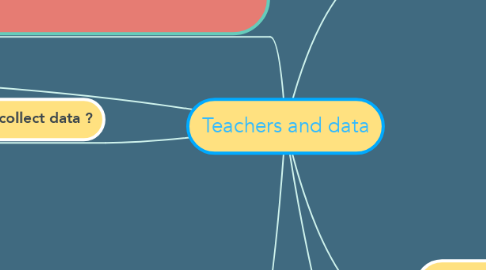
1. What can be done with data ?
1.1. Data can be collected through objective measures such as the Cincinnati public school teacher evaluation system. The data collected from research such as this can then be collated and used to distinguish which attributes particular teachers in question hold which benefit children in attainment within core subjects.
1.1.1. The gains in a students learning are used to measure the quality of a teacher.
1.2. •To determine students need to learn specific content, teachers can use the diagnostic approach by collecting data on their performance. Idea – could also use the data collected to provide feedback on students work. The diagnostic approach allows teachers to identify areas of strength and weakness in what the students have learned, allowing both teacher and pupil to reflect on their learning.
1.2.1. •Another approach to using data is the teachers approach where teachers can collect data on classroom events by focusing on student/teacher thinking which can lead to identifying dilemmas and develop ways to manage them effectively. The teacher approach uses beliefs and knowledge to make fundamental changes in the classroom to ensure that their teaching is consistently as effective as it can be (Wieman, 2014:551).
1.2.2. •Teachers can also use the methods approach which looks at how the way that the teacher, teaches and how this impacts the pupils overall performance (Wieman, 2014: 550). This can help to determine the aspects of teaching such as, data on teachers moves and implementation. This can lead to teachers adopting new methods to effectively support students learning.
2. Why teachers collect data ?
2.1. To improve their practice and support pupils in attainment.
2.2. To improve instructions and teaching practices.
2.3. Data is vital for teachers. They use data, policy and their own intuition to reflect and assess students progress.
3. Key sources
3.1. Kane, T.J., Taylor, E.S., Tyler, J.H. & Wooten, A.L. (2011) ‘Identifying Effective Classroom Practices Using Student Achievement Data’ in Journal of Human Resources, 46 (3), pp. 587-613.
3.2. Wieman, R. (2014) ‘Using Data to Improve Instruction: Different Approaches for Different Goals’ in Action in Teacher Education, 36 (5-6), pp. 546-558.
3.3. Datnow, A., Park, V. & Kennedy-Lewis, B. (2012) ‘High School Teachers' Use of Data to Inform Instruction’ in Journal of Education for Students Placed at Risk (JESPAR), 17 (4), pp. 247-265.
4. Key Themes • Data-driven decision making (DDDM) is the process by which administrators and teachers collect and analyse data to guide educational decisions (Daton et al, 2012;247)
5. Why is it important to improve quantitative skills ?
5.1. To improve economic efficiency at a national level.
5.1.1. Individuals confident in research and analysis.
5.2. DDDM is built on a ‘Technical-Rational’ model. This relates to many US educational reforms from the mid-late 90s embody this perspective, building on ‘classical management theory’ which focuses on the skills that workers need for work. This would be very relevant in modern society as children should leave school equipped with the skills they need for working life. (Daton et al, 2012;247-250)
6. What teachers do with data
6.1. Effectively analyse their practice within the classroom, and identify which personal attributes lead to higher pupil attainment within core subjects.
6.1.1. Data collected on best practice can in turn lead to greater job opportunities if accredited with high scores in observable data.
6.2. Teachers can use different approaches to collect data for different outcomes in order to improve their teaching and provide students with more effective learning. It can serve the purpose of allowing pupils and teachers to reflect on the progress that has been made throughout the year and identify areas for improvement.
6.2.1. Educational Leaders agree and praise teachers who use data to improve their own instruction and teaching. However, it appears that analysing data to improve teaching is an arduous task and often not very clear. Whilst some of the approaches make it easy to see where improvement has to be made, the data itself does not help teachers act on what has been discovered. This is why it can be very difficult as there is little support given to act on the data they have collected (Wieman, 2014:553) .
6.3. The way / extent that teachers use data varies within the school and depends on subject - In “High School B in District B, there was overwhelming consensus about the importance of using data to improve teacher performance and student achievement […but] several teachers pointed out that all departments did not share an equal burden for student achievement.” (Daton et al, 2012;258)
6.3.1. The school and subject area are very significant in shaping the teachers’ use of data. However, there was a strong agreement amongst teachers on the importance of using data. Data is vital for teachers. They use data, policy and their own intuition to reflect and assess students progress. (Daton et al, 2012;262-264)
